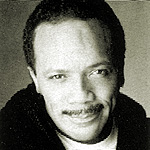Quincy Jones is one of those rare individuals whose career in contemporary music-making spans virtually four decades, not only on the calendar itself but also in the almost constant churning of what we loosely call “popular music.” And the most unique thing about it is that Quincy Jones today is quite possibly at the zenith of his creativity and acclaim.
He is perhaps best known at this sunset of the 80s, as the producer of Michael Jackson’s most enormous hits, including the amazing “Thriller” in 1982, as well as arranger producer of the historic “We are the World” recording session. But Jones was a music man, musician, writer and arranger in actual fact considerably before Michael Jackson’s birth.
Jones’ career spans the post-swing era of the late 40s to today’s high tech, international multi-media hybrids. In the mid-SOs, he was the first popular conductor-arranger to record with a Fender bass, a period when the name Fender was equated only with the word “bass,” rather than guitars in general, as it is today.
During his lengthy and productive career, Jones has played virtually all the roles, in many cases breaking new ground as he made his way. He has been composer, record producer, artist, film producer, arranger, conductor, musician, television producer, record company executive and one of the very few who so easily bridges the gap between artistic creativity and running the business in the boardroom.
Born in Chicago in 1933, Jones grew up in Seattle where he began making music playing trumpet and singing in a gospel choir at the age 12. His first band was formed with his friend, Ray Charles, who was two years older, when both were in their teens. Later he attended the prestigious Berklee School of Music in Boston, following this up, a year later, with a move into the mainstream of the New York music scene, meeting and associating with such jazz figures as Art Tatum, Thelonious Monk, Charlie (Bird) Parker and Miles Davis, in the process. Jones worked on the road with the Lionel Hampton Band between his many session assignments in New York where he arranged for such widely disparate talents as Ray Anthony and Tommy Dorsey on the one hand, and Dinah Washington, Duke Ellington, Count Basie and Cannonball Adderley on the other.
He was a member of the Dizzy Gillespie Band on the first-ever State Department sponsored tour (The Middle East and South America). Following this, he signed his first contract with Mercury Records in 1957. He decided to continue his musical education by studying with Nadia Boulanger, the legendary Parisian tutor to American expatriate composers such as Leonard Bernstein and Aaron Copeland. Later, he became director of artists and repertoire for Mercury, in the process, discovering and making a star out of the singer, Lesley Gore.
At Mercury, Jones ultimately served as Vice President, achieving for that period the highest level job status yet attained by a black executive working with an established firm. He also became active composing for film scores, his most important efforts including the soundtracks for “In Cold Blood,” and the multi Oscar winning “In the Heat of the Night,” in 1967. And, in 1971, Jones conducted the Academy Award Orchestra.
In 1969, Jones began a successful 10-LP association as an artist with A&M Records during which time he recorded, “Body Heat,” his first gold album, which in its own way became a kind of sign of the times, replacing the orchestral scorings with a funky, driving, rhythm section with synthesizers and guitars. Almost immediately following “Body Heat,” Jones suffered two aneurysms and survived, against great odds, two delicate surgical procedures.
Other laurels added along the way in the late 70s were the score for the landmark TV series, “Roots,” for which he won an Emmy and his movie adaptation of the score for Broadway’s “The Wiz,” for which he received an Oscar nomination. Another triumph, his final LP for A&M, “The Dude,” won him a Grammy as Producer of the Year along with five others for the album itself. Jones has received 20 Grammy Awards, tied to first place with Henry Mancini.
In addition to his well-documented successes producing Michael Jackson’s albums, “Off the Wall,” “Thriller” and “Bad,” Jones is also head of his own record company, Qwest Records, which currently enjoys an impressive artist roster which includes Siedah Garrett, New Order and The Winans, among others. In 1983, his career took yet another diagonal turn, into film production, where he worked as line producer with Kathy Kennedy and Frank Marshall on the landmark motion picture, “The Color Purple,” which had 11 Academy Award nominations, including Steven Spielberg as Best Director.
Reflecting on the changes in pop music, Jones has said, “If there are any common denominators, they are spirit and musicality. I’ve heard the rhythm section change many times…But looking at it more broadly, you find the same things coming back in different forms. Life is about patterns…Sooner or later it all comes back…I go for the music that give me goosebumps and that’ll be the truth.”


